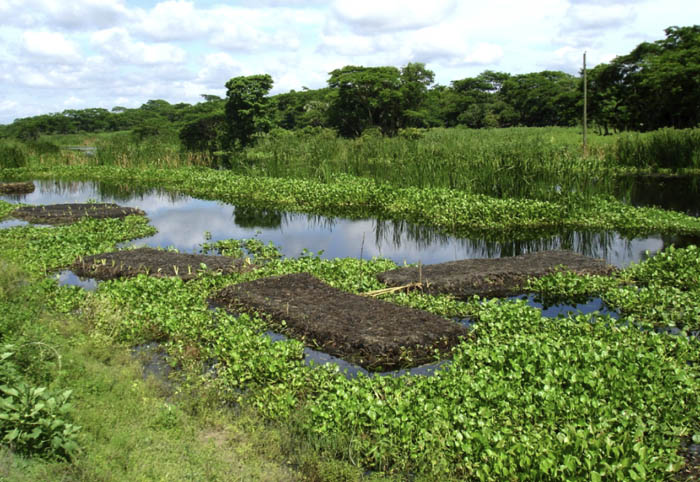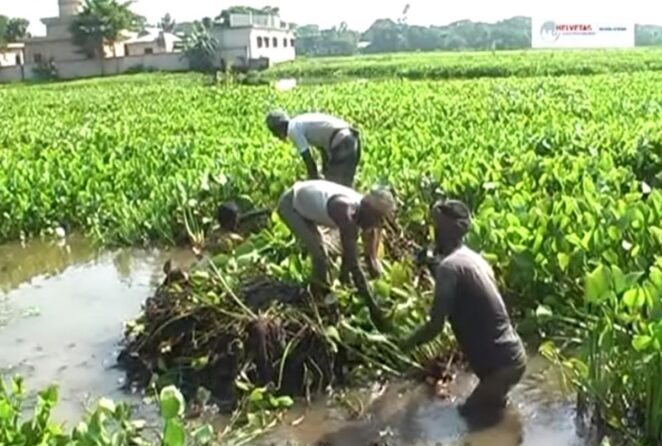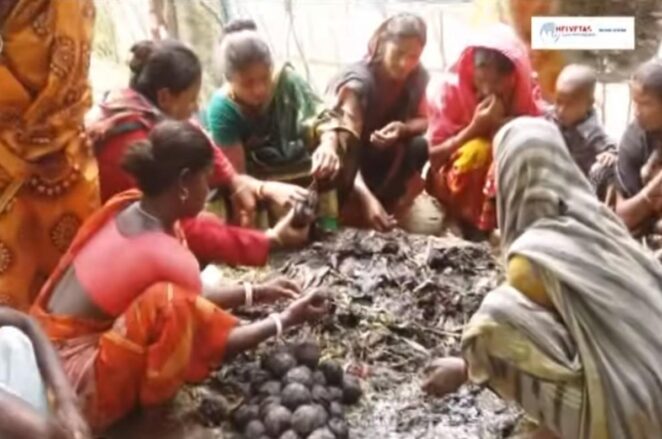Article /
How to make a Floating Vegetable Garden – Step by Step

This post has initially been shared on the Nature-based Solutions Initiative website.
Floating Agriculture in Bangladesh
Floating agriculture is a traditional practice in Bangladesh, which is now spreading between communities, allowing farmers to maintain or increase agricultural productivity in the face of increased monsoon season flooding. It involves weaving together aquatic plants, most commonly the invasive water hyacinth, to form floating beds that rise and fall with the water level. Crops planted in these beds avoid water logging, and benefit from the nutrient rich decomposing matter, reducing the need for chemical fertilizers. When the water level falls in winter, the beds are ploughed into the soil and used to grow winter crops.
This is a documentary presenting the construction of floating vegetable gardens step by step. At the end of the video, three persons who have received training on floating vegetables cultivation in Bangladesh share their experiences and its financial impact: two women farmers using floating agriculture and one man who sells his services to neighbouring farmers in the preparation of floating garden beds.
The video is widely used in Bangladesh for disseminating this innovative technology, where there is limited land for vegetable cultivation. For example, in haor areas like Sunamganj, Bangladesh most of the months lands goes under water.
This video is in both Bangla and English language.
A step-by-step guide to floating beds for agriculture
Floating beds can be prepared at any time of the year. However, the most appropriate months are August and September. Floating beds can be prepared in places where water remains more than six months per year and an abundance of water hyacinth exist. Water hyacinth is the main material required for floating bed preparation. In addition, two pieces each of 30 feet long bamboo, one piece of small bamboo, one knife and a long rope are required for the preparation.
Bed preparation
Beds are most easily prepared where the water level remains low.
- STEP 1:
- First, the two long bamboo pieces are put on top of the water hyacinths.
- Then, water hyacynths are gathered on top of the bamboo pieces, making sure to always keep the balance.
- Water hyacinths are woven into each other.
- The bamboo is removed from underneath after certain preparation of bed.
- This process will be repeated several times until the final height of the bed is reached. Minimal height should be 3 feet from the water table.
- STEP 2: The bed has then to be shaped into the right size (see video for guidance on sizing) and levelled by cutting water hyacinths on all four sides.
- STEP 3: In the following 20-25 days, the bed is left fallow for decomposition of the top layer water hyacinth. It is important that the top level of the bed is never drying out to assure maximum potential yield.
When its colour turns black, the bed is ready for seed sowing or seedling transplantation, either through a broadcasting method for direct seed sowing or translplantation in lines.

Method for seedling preparation in water balls
- STEP 1: Collect decomposed water hyacinth and prepare the decomposed water hyacinth by smashing it.
- STEP 2: Balls are hand prepared. Excess water is removed by applying light pressure on the water hyacinth balls. Size of the ball should be 2 to 2.5 times bigger than the size of the seed.
- STEP 3: A small hole is pierced in the balls. One to three seeds are put into the hole, depending of the size of the ball. After butting the seed, the holes are closed by hand.
- STEP 4: At the transplanting stage, the seedlings are transported with the balls to the prepared floating land.

For more details, see the video.
This documentary has been developed under the project Agricultural Innovations for Eliminating Extreme Poverty (AIEEP) Project, funded by EEP-Shiree/DFID, and implemented by HELVETAS Swiss Intercooperation-Bangladesh.
